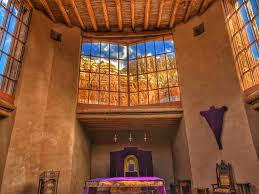Mark 1:35-37 NRSVue
1 Come and find the quiet centre in the crowded life we lead,
find the room for hope to enter, find the frame where we are freed:
clear the chaos and the clutter, clear our eyes, that we can see
all the things that really matter, be at peace, and simply be.
Voices United 374
On Friday I was in this curious bricks-and mortar retail store that sells books and little else. Imagine that such a place still exists! I was seeking Aflame: Learning from Silence, the latest by Pico Iyer, a travel writer who has now written a couple of books on the contemplative life. I discovered that while they had it on order it won't be released until later this month.
Lo and behold, Saturday's Globe and Mail newspaper -- I still get one newsprint paper a week, Luddite that I am -- had a feature article by none other than Pico Iyer. The Opinion section caption under the above photo was Soul Places: What we'll lose as monasteries disappear. The full page piece within had the bold headline HOSPITALS FOR THE SOUL. The article began:
To get to the Monastery of Christ in the Desert, just past Georgia O’Keefe’s Ghost Ranch in northern New Mexico, you have to bump for 13 miles on barely paved tracks. Signs warn of “FALLING ROCKS” and “FLASH FLOODS” and the update posted by the guestmaster monk online alerts visitors each day to treacherous road conditions. “All-wheel drive vehicles are advised...”
Some of you may recall that I have written about visiting Christ in the Desert monastery and the Ghost Ranch retreat house called Casa del Sol some years ago. In fact, years ago while on what was largely a silent retreat at Casa del Sol -- in January --I set out in my rental car without either all-wheel drive or snow tires to drive those 20+ kilometres to Christ in the Desert, passing an SUV with both where the driver was dealing with a flat tire. I did stop and ask if he needed assistance and he assured me that AAA was on the way!
This quixotic venture may have been bordering on madness but it was a remarkable experience into the silence and astonishing beauty of the Chama River valley with a soupcon of mild terror.
A reproduction of this painting of the Chama River by Georgia O'Keeffe is in our home
Iyer reflects on his experiences in various places of spiritual renewal, so many of them connected to time-honoured religious orders:
Over more than three decades, I’ve stayed in monasteries in Japan, in Western Australia, in southern England and in California. Indeed, I’ve made more than 100 solitary retreats just in the New Camaldoli Benedictine hermitage in Big Sur, Calif. – sometimes even staying with the monks in their enclosure.
I never come away from the place anything other than refreshed, clarified and full of joy; though I’m not a Christian, the monks open their hearts and doors to me without hesitation, faithful to St. Benedict’s call to hospitality. At the same time, I’m a perfect example of what I increasingly worry about; I’m happy to stay for a few days, offering the small voluntary donation the monastery suggests, but I’ve made no formal commitment to a place that has changed my life. Over the 33 years I’ve been staying there, I’ve seen the number of oblates – lay people who vow to honour the congregation’s principles as much as they can in everyday life – surge from 700 to 800; in that same time, the number of full-time monks has shrunk to almost single digits.
We’re surrounded, of course, by ever more New Age sanctuaries, retreat centres and yoga-inflected spas, yet what will be lost, I often wonder, if formal monasteries and convents based on lifelong commitments close down? Unlike new spiritual centres, they are not as a rule centred around a single teacher, a doctrine every guest is encouraged to follow, or some theory of existence discovered five years ago; they’re tested millennia-old establishments that don’t depend on one fallible human or yesterday’s revelations.
This resonates with my sensibilities when I stepped away from busy/hectic ministry to recollect myself in solitude and prayer. So often in these holy places, far from the madding crowd, I felt enveloped in the presence of God the Creator, Redeemer, Sustainer. They were truly "hospitals for the soul", noting that both hospital and hospitality come from the same root and hospitality is a Benedictine imperative.
While the range of my experience doesn't come close to Pico Iyer's I have been on retreat in Britain and France, along with a number of places in the United States and Canada. I was able to do this because of the funding available as a United Church minister through congregations and the denomination and I am very grateful. I appreciate what he is musing about here regarding the profound sense of tradition underlying the immediate gift of these settings, as well as the conundrum about the ongoing existence of such places.
I haven't spent time in a monastery or convent or retreat centre since retirement, although we have intentionally sought out prayerful silence through these years. I am grateful for the reminder by Pico Iyer and now I'll need to decide whether to purchase yet another book...you know which way I'm leaning.




No comments:
Post a Comment